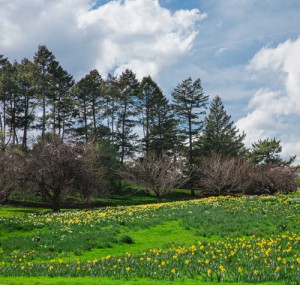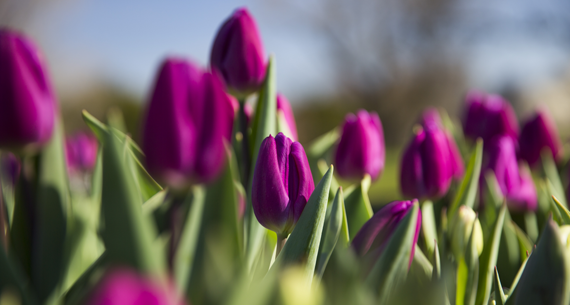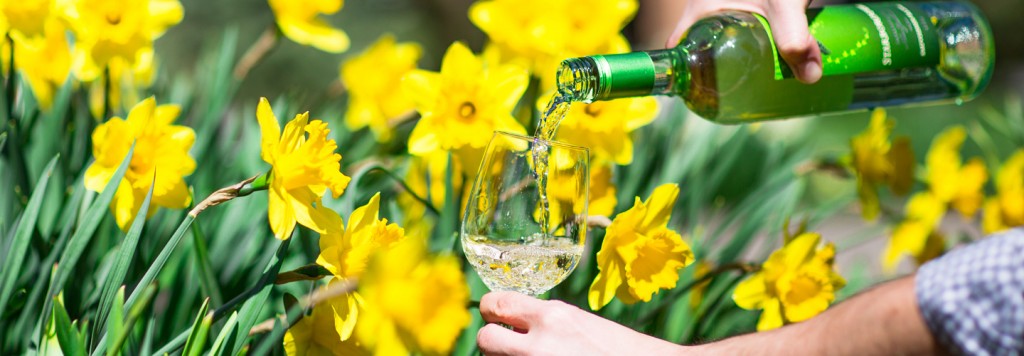Spring Bulb Basics: NYBG Experts Answer FAQs
Posted in Horticulture on April 4 2016, by Joyce Newman
Joyce H. Newman is an environmental journalist and teacher. She holds a Certificate in Horticulture from The New York Botanical Garden.
 Two bulb experts, Michael Hagen, Curator of the Rock Garden and Native Plant Garden, and Marta McDowell, NYBG instructor, author, gardener, and landscape historian, recently commented on some frequently asked questions about the gorgeous spring bulbs now blossoming in the garden . Here’s what they had to say.
Two bulb experts, Michael Hagen, Curator of the Rock Garden and Native Plant Garden, and Marta McDowell, NYBG instructor, author, gardener, and landscape historian, recently commented on some frequently asked questions about the gorgeous spring bulbs now blossoming in the garden . Here’s what they had to say.
Q: What are some of the easiest spring/early summer bulbs to grow?
McDowell: Narcissus seem to be almost indestructible and with so many varieties, you can have them in bloom for almost two months. Other choices: Crocosmia—graceful in leaf and flower and blackberry lily (Iris domestica or Belamcanda chinensis). Great foliage, flowers, and seed pods.
Q: What are some of the most difficult bulbs to grow, aside from climate issues?
Hagen: Climate aside, the hardest to grow are the ones that our native ground squirrels, chipmunks, woodchucks, and gophers enjoy eating. Species tulips have been a particular challenge in the Rock Garden. If it’s a warm fall (and the chipmunks are not hibernating yet) they can be dug up and eaten right after they’ve been planted.
Q. What are some of your favorite bulbs?
Hagen: Miniature Narcissus, species tulips, and Erythroniums—their ethereal beauty speaks for itself. I’m also very fond of the pale china blue Muscari ‘Valerie Finnis’.
McDowell: Little blue bulbs—Scilla siberica and Chionodoxa. They are such a glorious color. Also species tulips and the little bulbous irises like I. reticulata. So delicate, and, since my garden is small, good players—for me with miniature hosta. Also parrot tulips—ga ga over ‘Black Parrot’—and lilies. My favorite is ‘Black Beauty’ and Magic lilies (Lycoris squamigera) because my Aunt Mary Brandt grew them, and her garden was total magic to me when I was growing up.

Q. When it comes to native bulbs in the Rock Garden and Native Plant Garden, what are some good choices for the spring and early summer season?
Hagen: There are native rhizomatous perennials like Trillium or Sanguinaria that have a similar “ephemeral” behavior to spring bulbs, or bulbs such as Camassia that need to be grown in a damp/wet location (no burrowing rodents), but probably the best choice for a native bulb is nodding onion (Allium cernuum). For those wanting something for the woodland, trout lily (Erythronium americanum) is a good choice, though they tend to spread vegetatively, and the speckled foliage is attractive, rather than a big floral display. This tends only to happen reliably in older established clumps.
Q. Which bulbs seems to be trendy now?
McDowell: Dahlias—especially the smaller ones. Great for cutting and beautiful fall show. If you live in an area where they are not hardy and don’t feel like digging them, you can treat them like annuals. I dig them in the fall and replace them with tulips. After the tulips are done, I put the dahlias back in.
Native bulbs are also trendy. There are so many lovely spring ephemerals. In my garden, I’ve added trillium, bloodroot, trout lilies and, my personal favorite, Dutchman’s breeches (Dicentra cucullaria).
Historic bulbs are featured on the Old House Gardens Heirloom Bulbs website. Brent and Becky’s gardens also have added “date of introduction” in their bulb catalog.
Edibles: Garlic is beautiful in bloom (I love to eat the scapes, too).
Miniature bulbs for anyone downsizing their garden—you can even grow them in patio troughs.

For daffodil lovers:
To celebrate NYBG’s 125th Anniversary, the Garden is dramatically expanding the historic Narcissus collection at Daffodil Hill—150,000 bulbs were planted in October 2015 and 1,000,000 will be planted for the Garden’s anniversary. On Saturday, April 23, and Sunday, April 24, during Daffodil Celebration & Wine Weekend, you can take a walk with an NYBG gardener or guide while enjoying local wines from New York State vintners. Experts on wine-making and viticulture will host demonstrations and discussions during presentations of their crafts.


More information about growing and caring for bulbs can be found via the NYBG Plant Information Website! http://libguides.nybg.org/search.php?iid=1886&gid=0&c=0&search=bulbs